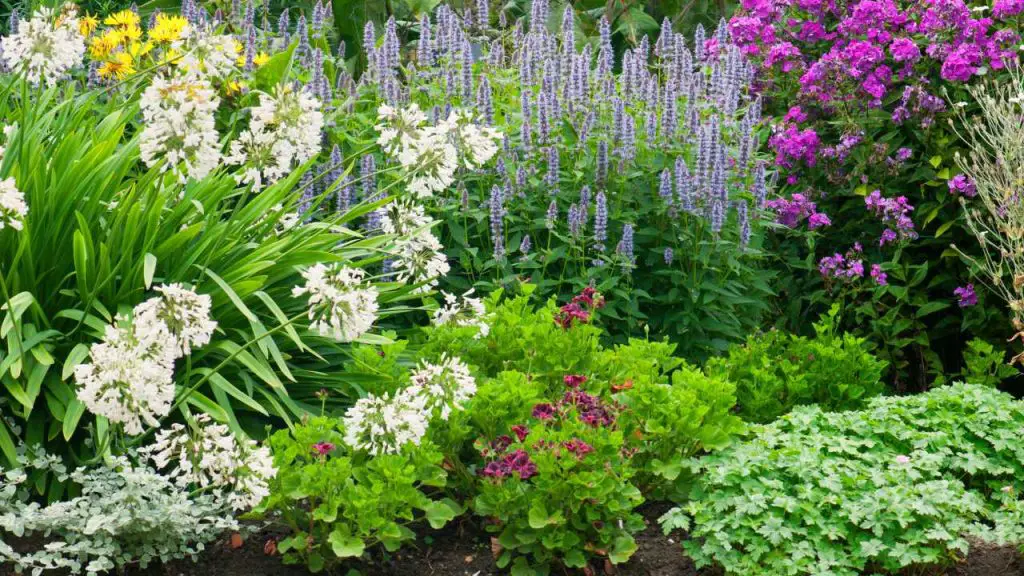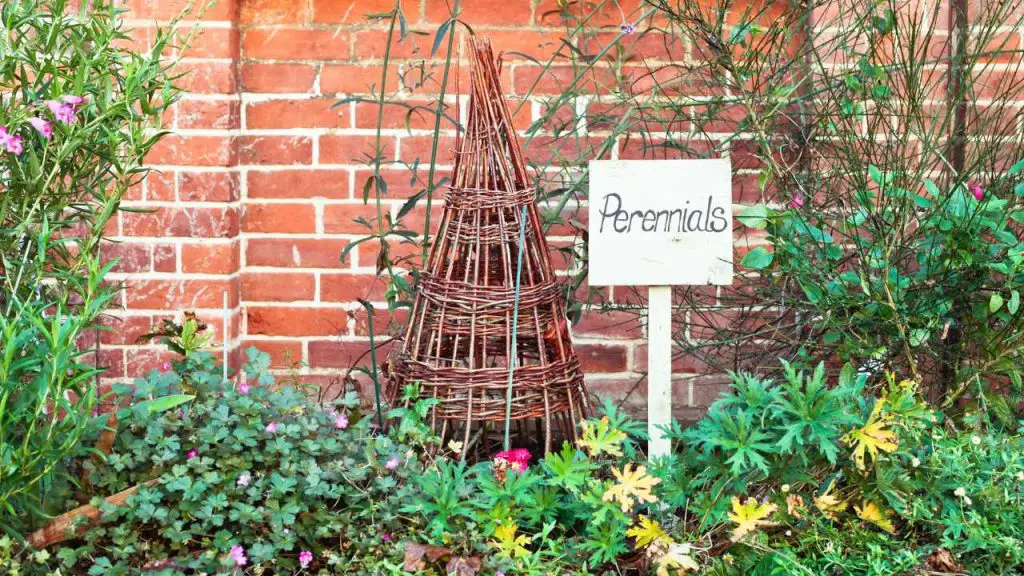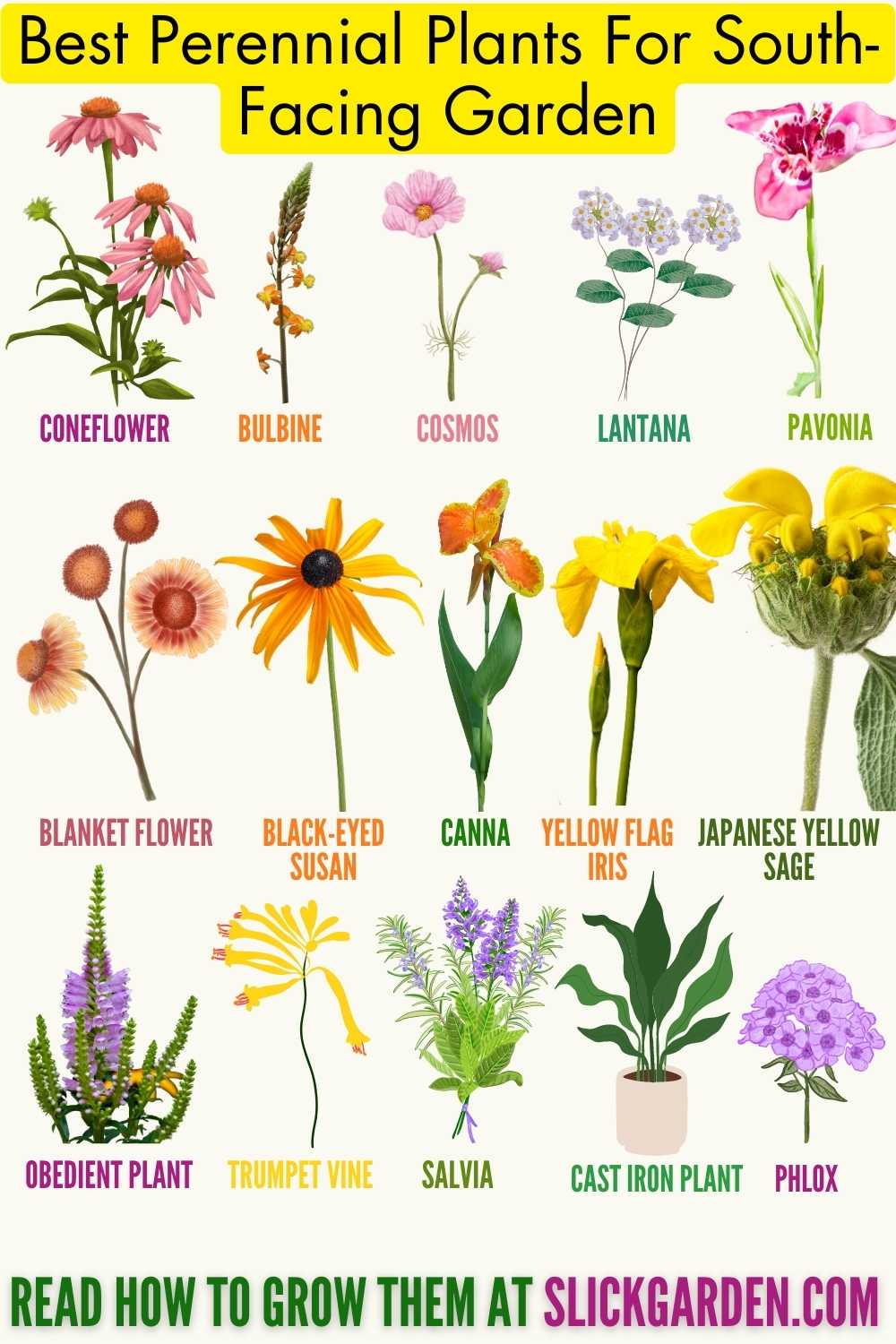A south-facing garden is primarily oriented toward the south and receives direct sunlight throughout the day. This garden is an ideal place for plants that love sunny locations.
Such plants receive the maximum amount of sunlight when you grow them in a south-facing garden. These gardens are warmer than gardens facing other directions.

You can choose sun-loving plants such as herbs, vegetables, and flowering perennials for a south-facing garden. These plants require full sun exposure for their healthy growth.
When vegetable plants like tomatoes and peppers receive the required amount of sunlight, they will produce maximum yield for you.
The characteristics of a south-facing garden depend upon many factors like surrounding structures, geographical location, and landscaping elements.
Before choosing the perineal plants for a south-facing garden you must consider all the above factors.
Pros And Cons Of South-Facing Garden

When you are planning a south-facing garden then you should keep in mind the climate, local conditions, and the need for the plants that you choose for growing.
For your success write a selection of plants, proper planning, and maintenance are required. If you work on all the factors then you can create a beautiful south-facing outdoor space for your plants.
Following are the pros and cons of a south-facing garden because of its orientation towards the south.
PROS
- This is a sunny outdoor growing space so the most crucial benefit for those plants that are sun-loving is they receive maximum sunlight throughout the day.
- Because of the south-facing direction, this garden receives maximum sunlight and creates a warm environment for heat-loving plants. This will help to extend the growing season.
- A wide range of plants can be selected for growing in a south-facing garden because most plants like to thrive in sunny conditions. You can select sun-loving perennials, annuals, vegetables, and herbs for such gardens. These plants perform well because of the desired environment for them. As you know fruits, herbs, and vegetables need full sun exposure for producing healthy crops for you. It means a south-facing garden is an ideal place for edible plants.
- You can design your south-facing garden in many ways. You can grow sun-loving plants that produce vibrant blooms and are sitting set up in your garden when they receive maximum sunlight.
- A south-facing garden is a perfect location for installing your solar panels as it will maximize solar energy generation.
CONS
- The sunlight and warmth speed up the evaporation process in the soil. It means you have to be careful about the watering requirement. More heat will dry up the soil very quickly and your plants need more water.
- If you are living in a hot climate then intense afternoon sun can damage your plants. So they require additional shade or protection from the sun.
Best Perennial Plants For South-Facing Garden

Following is the list of 15 perennial plants that can grow well in a south-facing garden.
1- CONEFLOWER
The first plant that is included in our list is the cornflower. This beautiful plant prefers the full sun. It is suggested that you must use well-drained soil because they are drought-tolerant flowering plants.
To make your soil more rich you can add compost or aged manure to increase its fertility. The ideal time for planting corn flowering plants is in spring or early summer.
You can buy iron plants from any local nursery but you can also grow corn flours by seed. The recommended varieties of cornflowers are Robert Bloom, Finale White, Narrow-leaf corn flour, Pale purple cornflower, and Sanguine purple cornflower.
You can use these charming flowers for arrangements when their petals are expanding. The vase life of cornflowers is about 5 to 7 days.
2- BULBINE
You can select this flowering plant for your south-facing garden. This fast-growing perennial plant has fleshy linear green leaves with onion-like petals. 6 petals star-shaped small flowers spread during spring the colour of the petals is yellow or orange with yellow stamens.
The interesting thing about this plant is that it needs little care and is a drought-resistant plant. You can easily choose this plant. Make sure you are using a well-drained soil with all the required nutrients.
To keep your plants healthy you should prune them regularly. You should remove dead flowers’ heads because it encourages new growth. The fully sunny area is perfect for this plant so you can easily grow it in a south-facing garden.
You can propagate bulbine plants from seeds, division of clams, and cuttings. The ideal time for planting is in spring. If you are growing from seeds then when the young seedlings have 4 leaves this is the perfect time for transplanting them to their desired location.
3- COSMOS
Another colourful flowering plant is the cosmos which is perfect for your south-facing perennial garden. This perennial plant likes to grow in dry and hot locations. This plant needs little maintenance so it is a perfect choice for you.
You can start this plant from seed. Buying a young plant is also a better option for you. You can also grow it in containers or pots but you must choose dwarf varieties. You can use cosmos flowers in your arrangement.
4- LANTANA
Another plant that can tolerate heat is lantana. You can grow lantana from seeds or cuttings. If you decide to grow this flowering plant from cuttings then make sure you are taking all the cutting from a healthy plant.
Take 4 to 6 inches of cuttings and remove the lower leaves. Now dip the end in rooting hormone this will help in developing the new roots. When you see the roots are 3 to 4 inches long then you can plant these cuttings in the soil of the ground of your south-facing garden.
Keep the soil moist as it receives its desired sunlight when you grow it in your south-facing garden.
You can fertilize this plant by applying 20-20-20 every 2 to 3 months. You will get all the information about dosage on the label of the bag of fertilizer. To encourage the new growth you should remove faded flowers from the plant.
5- PAVONIA
Another ornamental flowering plant that becomes a focal point in your south-facing Garden. This plant prefers full sun so a south-facing garden is a perfect place.
Loose, sandy soil is perfect for growing pavonia. You can make the soil richer by adding fertilizer. This plant can’t grow well in overly cold or hot environments.
6- BLANKET FLOWER
Blanket flowers can tolerate heat and humidity. This is a tough perennial plant that can tolerate drought well. It means you can choose it for growing in a south-facing garden.
This flowering plant produces colourful blooms and the blanket flower plants produce blues until prose. This plant can grow up to 1 to 2 feet tall and wide.
Gaillardia wants all the sun to grow taller. If you want to grow this flowering plant from seed then it is suggested that you should buy high-quality seeds. Blanket flowers started blooming non-stop in a sunny environment in early May.
7- BLACK-EYED SUSAN
If you want that Black-Eyed Susan plants to produce the best flowers for you then you select a sunny location for them. Make sure this plant is growing in well-drained and moist soil.
Maintain the frequency of water but avoid over-watering because this plant doesn’t like wet feet. As a sun-loving plant, you can grow it in a south-facing garden because it needs 6 to 8 hours of sunlight daily. It can also grow in shade but the colour of the flowers is not vibrant.
8- CANNA
A sunny place is an ideal location for cannas. This plant can easily adjust to a hot climate. When you select it for your south-facing garden then make sure you increase the frequency of water because of the high heat rays of the sun.
The soil dries out very quickly. Rich and moist soil with neutral pH is perfect for growing cannas.
As it is mentioned above that this plant likes to grow in hot climates. If you are living in a cold area then this plant shows slow growth. Cannas need regular fertilizing.
You can feed this plant in early spring and mid-summer. Make sure you are following all the instructions that are printed on the label of the product.
9- YELLOW FLAG IRIS
Yellow flag Iris is an ornamental plant that prefers full sun. The sword-shaped leaves and attractive flowers make this plant the right choice for a south-facing garden.
You never let the soil dry and keep it moist by regular watering. If the yellow flag Iris does not get water on time then it will grow less vigorously. You can propagate yellow flag Iris by underground rhizomes.
Keep Reading
- 20 Gardening Hacks You Need To Know Now
- 20 Diy Garden Fence Ideas For Your Beautiful Garden
- 15 Stunning Gardening Hacks For Your Garden
10- JAPANESE YELLOW SAGE
A sunny location is perfect for growing Japanese sage because it needs 6 to 8 hours of Sunlight for producing better blooms. A warm climate is perfect for growing Japanese sage.
This plant produces flowers from summer to mid-autumn. The ideal time for planting Japanese yellow sage is in Early Spring so the plant establishes itself and produces blooms at the right time.
11- OBEDIENT PLANT
This perennial flowering plant is native to Eastern North America. Obedient plants attract pollinators and it can grow up to 4 inches tall if it receives the full Sun.
You can easily grow this plant in such a location where it receives full sun exposure. A south-facing garden is a perfect spot for growing pink tubular flowers.
This plant adds beauty to your south-facing garden. This plant can even adjust in clay soil which makes it more desirable because it can survive in any condition. Pollinators are attracted to it because of its nectar.
12- TRUMPET VINE
Trumpet wine produced blooms in the summer months. This plant needs full sun otherwise it will not produce flowers profusely. Besides flowers, 15 inches long leaves of trumpet vine are also very glossy and dark green.
Trumpet wine is like to grow in moist and well-drained soil. You have to maintain the frequency of water to maintain the moisture level of the soil. This plant needs one inch of water weekly.
13- SALVIA
Full sun and well-drained soil is the requirement for growing salvia plants in south-facing gardens. Your summer garden is incomplete without salvias because this plant has nectar-rich flowers that attract bees and other pollinators.
The exotic flowers produced from midsummer to the first frost you can’t neglect the foliage of this plant because it is also very aromatic.
This plant can’t tolerate cold and wet soil so you may lose salvia in the winter. The biggest problem you face will be keeping this plant in winter.
You must select the right cultivar according to the conditions of your area. If you are looking for long-lasting perennial salvias then you must select Salvia Nemorosa and Salvia x Sylvestris because this plant comes back year after year.
14- CAST IRON PLANT
Cast iron plant has extraordinary foliage that is perfect for a south-facing garden because it can withstand drought. You should water this plant when you see the soil is dry.
Overwatering and shady spots can lead to root rot and destroy your plant.
This plant can adjust in a wide range of soil but make sure it is well-drained, slightly acidic, sandy, and loamy soil. You can also grow this plant in pots but you must use high-quality potting mix, not garden soil.
The ideal temperature for growing this plant is between 60 and 75° Fahrenheit. If the temperature drops below 50° Fahrenheit then your plant will die.
15- PHLOX
Phlox likes to grow in sunny spots. Keep the soil moist because this plant is very sensitive to drought, especially in hot and dry weather. You should regularly examine the soil if it feels dry then water the plant and never let it dry because it needs little care.
Alpine Phlox needs plenty of sun so it is the perfect choice for growing in a south-facing garden.
You can easily propagate this plant by dividing them in early spring. If your garden has poor soil then you can amend it by adding fertilizer in a spring.
Phlox has sturdy stems although it grows very tall but rarely needs staking. Without thinking too much you can grow it in your garden because it is pest free and disease-resistant and lasts for years in your garden.
